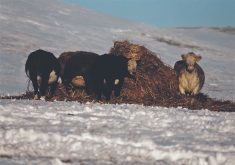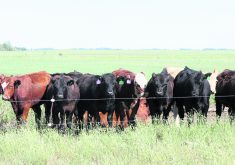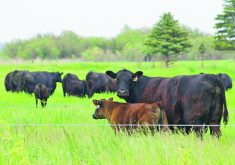Glacier FarmMedia – Work from a three-year pilot project aimed at understanding the livestock sector’s predator problem has become provincial policy.
On April 25, the federal and Manitoba governments jointly announced the Livestock Predation Prevention Program, funded through the Sustainable Canadian Agricultural Partnership.
The program builds on the Livestock Predation Prevention Pilot Project, an industry-led initiative that wrapped up last year. That pilot had a few main goals: quantify the scope of predator losses and get insight into local application of prevention strategies; find out which ones worked in Manitoba’s circumstances and determine how they meshed with farm operations.
The pilot was “really important as a stepping stone to developing this funding program,” said Manitoba Beef Producers general manager Carson Callum. “It tested a lot of the different options to mitigate risk and mitigate losses on farm.”
The pilot launched in 2020, spearheaded by MBP, Manitoba Agriculture and the Manitoba Sheep Association.
A producer survey early in the project found that 11,606 animals had been lost across 556 farms over a five-year period. Data from the Manitoba Agricultural Services Corporation supports those findings. Between 2015 and 2019, the insurance provider reported 7,675 cattle and 2,177 sheep lost.
The next phase involved producers willing to test prevention measures. Those ranged in scale and farmer investment and included anti-predator fencing, deadstock compost pens, GPS collars, cow bells and deterrents like lighting and fladry wire — flapping tape tied on a wire, designed to take advantage of wolves’ typical avoidance of unknown objects. More than 100 tests were done on 48 farms.
Callum said he has no hard numbers, but it seems like predation is on the rise.
“I know some of this will be cyclical. If you look at MASC claims, they go up and down depending on the year and various different factors that influence predation, but overall, it just feels like we’ve seen some major increase in predation challenges on farm.”
The new program earmarks $500,000 to reduce the risk of livestock predation and promote the co-existence of wildlife and livestock in agro-Manitoba.
“Predation-related challenges pose a significant concern for Manitoba’s livestock producers, who not only lose animals but experience significant economic losses as well,” said Manitoba Agriculture Minister Ron Kostyshyn.
“Producers will be able to make on-farm management changes that should reduce livestock predation and will help offset compensation claims under the Wildlife Damage Compensation Program funded by the federal and provincial governments.”
Two funding streams have been outlined. The Pre-approved Livestock Predation Equipment and Guardian Dog stream provides a rebate for things like solar foxlights, temporary fence options like electronet and fladry wire, and guardian dogs.
The Predator-Resistant Fence Construction funding stream supports construction of more permanent fencing to deter predators from entering calving and lambing areas, pastures, extended grazing areas and deadstock compost sites.
Eligible farmers must have had a paid livestock predation claim under the Manitoba Wildlife Damage Compensation Program since the start of 2021. Once approved, farmers can expect to be reimbursed up to 75 per cent of eligible expenses, to a maximum of $5,000 for the first stream, and $10,000 for fence construction.
“This funding will ensure our producers have access to the tools they need to modernize their operations so they can continue to farm alongside rural wildlife while protecting their bottom lines,” federal Agriculture Minister Lawrence MacAulay said.
Callum said MBP is happy with the program roll out. The list of funded projects includes several of the winning strategies identified by the pilot project, although he did have concerns with some eligibility criteria.
“Some things, such as having a wildlife damage compensation claim in 2021 or later, may need to be looked at as our organization dives deeper into the program and we start getting feedback in from our membership,” he said, suggesting the requirement was likely added to identify areas of greatest risk.

“When they start looking at uptake, they might be able to tweak the eligibility down the road once they see how many people are applying and how much budget they have left over.”
Overall, he said, “I think it’s laid out in a way that both balances what can be provided to producers and what is available in the budget.”
The April 25 joint statement also promised movement on the predator removal front.
MBP has engaged with the province on the Problem Predator Removal Program, which provides funds for producers to use trapping services. MBP has sought changes to that program, arguing that it lacks sufficient incentive for trappers.
“We’ve been hoping to see some positive steps forward to ensure that, when you’re having problems with predators that have figured out your mitigation and are still causing issues, they can be removed effectively and efficiently,” Callum said.
Government has promised more support for those efforts. The April 25 release earmarked an additional $90,000 for the removal program, for a total of $150,000.
“Manitoba’s livestock producers asked for help with predation, and our government listened,” said Jamie Moses, provincial minister for economic development. “Producers will now have the opportunity to be compensated for the preventive management issues that they have been dealing with for a number of years.”
Funds back anti-predation front-runners.


















